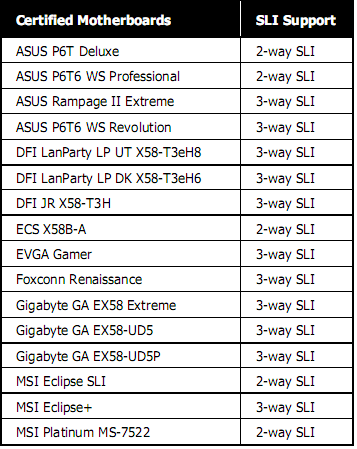
Nvidia SLI - now available on Intel chipsets
Intel'sActually... that’s not technically true – we’ve seen Intel P35/P45 motherboards used in some mobile (Clevo) chassis that Nvidia has allowed SLI to work with its mobile chipsets. So this is the first non-mobile, non specialist consumer application!
However that's not to say Nvidia won't get it's buck out of it - the certification process is rumoured to cost $5 a board - this is still far cheaper than the $20 it wanted to charge for the latest A3 revision of the NF200 chip, but it does mean that the consumer pays for SLI regardless of whether they want to use it or not. Nvidia's SLI brand is so strong that most companies are opting in, though.
There are limitations in what the X58 can offer - a maximum of x16-x8-x8 for three-way SLI isn't an optimal bandwidth solution, and an extra NF200 can boost one x16 into two x16 lanes, offering a full set of x16-x16-x16. Nvidia likes to further elaborate and even suggests that two NF200s will offer four PCI-Express 2.0 x16 lanes, just in case you've lost the ability to judge good value and you want to invest in three-way SLI and another card for PhysX, or perhaps you need eight monitors? Either way, actually fitting that many lanes on a board and squeezing performance cards into the limited space is surely a task for the good Doctor and his TARDIS.
 Some have opted for the Nvidia NF200 hardware; these will undoubtedly cost more, have an upgraded heatpipe-cooling and will become the premium solution in a range of X58s. Current licensees for the vanilla SLI certification include Asus, DFI, ECS, EVGA, Foxconn (we assume Quantum Force only, if at all), Gigabyte and MSI and NF200 kitted boards will follow the first wave, but won’t be launched together.
Some have opted for the Nvidia NF200 hardware; these will undoubtedly cost more, have an upgraded heatpipe-cooling and will become the premium solution in a range of X58s. Current licensees for the vanilla SLI certification include Asus, DFI, ECS, EVGA, Foxconn (we assume Quantum Force only, if at all), Gigabyte and MSI and NF200 kitted boards will follow the first wave, but won’t be launched together.Nvidia's certification process includes testing for stability in a "Super Stress [Test]", power provision, and functional layout testing including a mechanical check, and compatibility with its products in 2-way, 3-way and quad SLI where applicable. It also incorporates performance testing in "top 15 games" and "top benchmark tests", "PhysX Testing" and "Video Streaming".
Upon certification, an "SLI Key" is made available for manufacturers to include into their system BIOS, and the latest SLI drivers check for this certification key when it attempts to allow SLI. We wonder how long it takes for enterprising individuals to strip a key from a BIOS and update other BIOS' for non-X58 hardware. Fancy SLI on your Intel X48 or P45 for example?
For those who want to run ATI CrossFire, there's still no restriction on Intel chipsets and two slots is all that's needed for quad-CrossFire when using a pair of HD 3870 X2 or 4870 X2s. The use of the NF200 chipset also doesn't stop the use ATI's CrossFire and simply acts to increase the PCI-Express lanes, although naturally the Nvidia hardware enhancements such as the "PW Short" and "Broadcast" functions won't work.
Other Nvidia features are missing thanks to the lack of Nvidia hardware - the first of which is ESA. Clearly Nvidia is losing it grasp on the "platform" it worked so hard to build last year, as ESA's "open standard" has yet to do anything really worthwhile that can't be done with other hardware and free software.
It's still only available through a limited range of Nvidia motherboards right now and with Nvidia’s software. The hardware that launched with it doesn't seem to have continued to materialise either. Despite this, the X58 platform would have been a perfect example of the "enthusiast platform" but knowing that Intel does things like the selfish kid nobody wants to play with: i.e. "it's my way or else", we doubt we'll see it resurrected anytime soon.
The other is SLI Ready DDR3, or EPP2. While Intel XMP effectively competes directly with EPP2, it's Nvidia’s SLI Ready brand that is arguably more popular and even though Intel XMP has been available for over a year it's only very recently that manufacturers are taking an interest again. Despite the fact that EPP2 and XMP take up different parts of the SPD chip and can effectively co-exist, it'll unlikely happen because it would be a branding nightmare and BIOS engineers would specifically need to code to look for both. It is possible though as we've seen "XMP profiles" read EPP ones on Gigabyte DDR2 boards, and XMP isn't even available for DDR2!

MSI MPG Velox 100R Chassis Review
October 14 2021 | 15:04








Want to comment? Please log in.